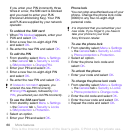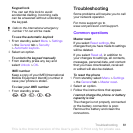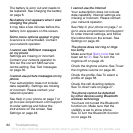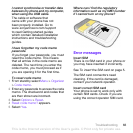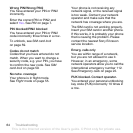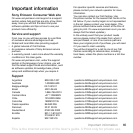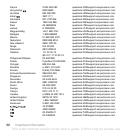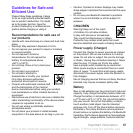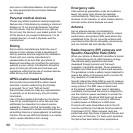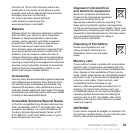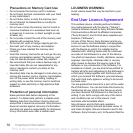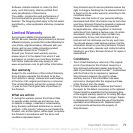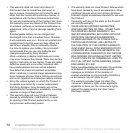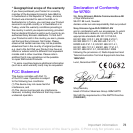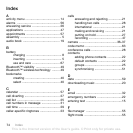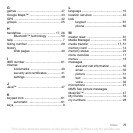68 Important information
and voice or data transmissions. Avoid danger
by using appropriate Sony Ericsson batteries
and chargers.
Personal medical devices
Phones may affect implanted medical equipment.
Reduce risk of interference by keeping a minimum
distance of 15 cm (6 inches) between the phone
and the device. Use the phone at your right ear.
Do not carry the phone in your breast pocket. Turn
off the phone if you suspect interference. For all
medical devices, consult a physician and the
manufacturer.
Driving
Some vehicle manufacturers forbid the use of
phones in their vehicles unless a handsfree kit
with an external antenna supports the installation.
Check with your vehicle manufacturer’s
representative to be sure that your phone or
Bluetooth handsfree will not affect the electronic
systems in your vehicle. Full attention should be
given to driving at all times and local laws and
regulations restricting the use of wireless devices
while driving must be observed.
GPS/Location based functions
Some products provide GPS/Location based
functions. Location determining functionality
is provided “As is” and “With all faults”.
Sony Ericsson does not make any representation
or warranty as to the accuracy of such location
information.
Use of location-based information by the device
may not be uninterrupted or error free and may
additionally be dependent on network service
availability. Please note that functionality may be
reduced or prevented in certain environments such
as building interiors or areas adjacent to buildings.
Caution: Do not use GPS functionality in a manner
which causes distraction from driving.
Emergency calls
Calls cannot be guaranteed under all conditions.
Never rely solely upon phones for essential
communications. Calls may not be possible in
all areas, on all networks, or when certain network
services and/or phone features are used.
Antenna
Use of antenna devices not marketed by
Sony Ericsson could damage your phone, reduce
performance, and produce SAR levels above the
established limits. Do not cover the antenna with
your hand as this affects call quality, power levels
and can shorten talk and standby times.
Radio frequency (RF) exposure and
Specific Absorption Rate (SAR)
When your phone or Bluetooth handsfree is turned
on, it emits low levels of radio frequency energy.
International safety guidelines have been
developed through periodic and thorough
evaluation of scientific studies. These guidelines
establish permitted levels of radio wave exposure.
The guidelines include a safety margin designed to
assure the safety of all persons and to account for
any variations in measurements.
Specific Absorption Rate (SAR) is used to measure
radio frequency energy absorbed by the body when
using a phone. The SAR value is determined
at the highest certified power level in laboratory
conditions, but because the phone is designed to
use the minimum power necessary to access the
chosen network, the actual SAR level can be well
below this value. There is no proof of difference
in safety based on difference in SAR value.
Products with radio transmitters sold in the US
must be certified by the Federal Communications
Commission (FCC). When required, tests are
performed when the phone is placed at the ear and
when worn on the body. For body-worn operation,
the phone has been tested when positioned a
This is the Internet version of the User's guide. © Print only for private use.



